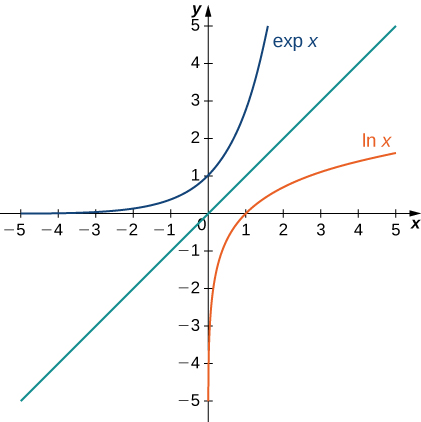Learning Outcomes
- Recognize the derivative and integral of the exponential function.
- Prove properties of logarithms and exponential functions using integrals.
- Express general logarithmic and exponential functions in terms of natural logarithms and exponentials.
The Exponential Function
We now turn our attention to the function [latex]{e}^{x}.[/latex] Note that the natural logarithm is one-to-one and therefore has an inverse function. For now, we denote this inverse function by [latex]\text{exp}x.[/latex] Then,
The following figure shows the graphs of [latex]\text{exp}x[/latex] and [latex]\text{ln}x.[/latex]

Figure 4. The graphs of [latex]\text{ln}x[/latex] and [latex]\text{exp}x.[/latex]
We hypothesize that [latex]\text{exp}x={e}^{x}.[/latex] For rational values of [latex]x,[/latex] this is easy to show. If [latex]x[/latex] is rational, then we have [latex]\text{ln}({e}^{x})=x\text{ln}e=x.[/latex] Thus, when [latex]x[/latex] is rational, [latex]{e}^{x}=\text{exp}x.[/latex] For irrational values of [latex]x,[/latex] we simply define [latex]{e}^{x}[/latex] as the inverse function of [latex]\text{ln}x.[/latex]
Definition
For any real number [latex]x,[/latex] define [latex]y={e}^{x}[/latex] to be the number for which
Then we have [latex]{e}^{x}=\text{exp}(x)[/latex] for all [latex]x,[/latex] and thus
for all [latex]x.[/latex]
Properties of the Exponential Function
Since the exponential function was defined in terms of an inverse function, and not in terms of a power of [latex]e,[/latex] we must verify that the usual laws of exponents hold for the function [latex]{e}^{x}.[/latex]
Properties of the Exponential Function
If [latex]p[/latex] and [latex]q[/latex] are any real numbers and [latex]r[/latex] is a rational number, then
- [latex]{e}^{p}{e}^{q}={e}^{p+q}[/latex]
- [latex]\frac{{e}^{p}}{{e}^{q}}={e}^{p-q}[/latex]
- [latex]{({e}^{p})}^{r}={e}^{pr}[/latex]
Proof
Note that if [latex]p[/latex] and [latex]q[/latex] are rational, the properties hold. However, if [latex]p[/latex] or [latex]q[/latex] are irrational, we must apply the inverse function definition of [latex]{e}^{x}[/latex] and verify the properties. Only the first property is verified here; the other two are left to you. We have
Since [latex]\text{ln}x[/latex] is one-to-one, then
[latex]_\blacksquare[/latex]
As with part iv. of the logarithm properties, we can extend property iii. to irrational values of [latex]r,[/latex] and we do so by the end of the section.
We also want to verify the differentiation formula for the function [latex]y={e}^{x}.[/latex] To do this, we need to use implicit differentiation. Let [latex]y={e}^{x}.[/latex] Then
Thus, we see
as desired, which leads immediately to the integration formula
We apply these formulas in the following examples.
Example: Using Properties of Exponential Functions
Evaluate the following derivatives:
- [latex]\frac{d}{dt}{e}^{3t}{e}^{{t}^{2}}[/latex]
- [latex]\frac{d}{dx}{e}^{3{x}^{2}}[/latex]
Try It
Evaluate the following derivatives:
- [latex]\frac{d}{dx}(\frac{{e}^{{x}^{2}}}{{e}^{5x}})[/latex]
- [latex]\frac{d}{dt}{({e}^{2t})}^{3}[/latex]
Watch the following video to see the worked solution to the above Try It.
Example: Using Properties of Exponential Functions
Evaluate the following integral: [latex]\displaystyle\int 2x{e}^{\text{−}{x}^{2}}dx.[/latex]
Try It
Evaluate the following integral: [latex]\displaystyle\int \frac{4}{{e}^{3x}}dx.[/latex]
Watch the following video to see the worked solution to the above Try It.
Try It
General Logarithmic and Exponential Functions
We close this section by looking at exponential functions and logarithms with bases other than [latex]e.[/latex] Exponential functions are functions of the form [latex]f(x)={a}^{x}.[/latex] Note that unless [latex]a=e,[/latex] we still do not have a mathematically rigorous definition of these functions for irrational exponents. Let’s rectify that here by defining the function [latex]f(x)={a}^{x}[/latex] in terms of the exponential function [latex]{e}^{x}.[/latex] We then examine logarithms with bases other than [latex]e[/latex] as inverse functions of exponential functions.
Definition
For any [latex]a>0,[/latex] and for any real number [latex]x,[/latex] define [latex]y={a}^{x}[/latex] as follows:
Now [latex]{a}^{x}[/latex] is defined rigorously for all values of [latex]x[/latex]. This definition also allows us to generalize property iv. of logarithms and property iii. of exponential functions to apply to both rational and irrational values of [latex]r.[/latex] It is straightforward to show that properties of exponents hold for general exponential functions defined in this way.
Let’s now apply this definition to calculate a differentiation formula for [latex]{a}^{x}.[/latex] We have
The corresponding integration formula follows immediately.
Derivatives and Integrals Involving General Exponential Functions
Let [latex]a>0.[/latex] Then,
and
If [latex]a\ne 1,[/latex] then the function [latex]{a}^{x}[/latex] is one-to-one and has a well-defined inverse. Its inverse is denoted by [latex]{\text{log}}_{a}x.[/latex] Then,
Note that general logarithm functions can be written in terms of the natural logarithm. Let [latex]y={\text{log}}_{a}x.[/latex] Then, [latex]x={a}^{y}.[/latex] Taking the natural logarithm of both sides of this second equation, we get
Thus, we see that all logarithmic functions are constant multiples of one another. Next, we use this formula to find a differentiation formula for a logarithm with base [latex]a.[/latex] Again, let [latex]y={\text{log}}_{a}x.[/latex] Then,
Derivatives of General Logarithm Functions
Let [latex]a>0.[/latex] Then,
Example: Calculating Derivatives of General Exponential and Logarithm Functions
Evaluate the following derivatives:
- [latex]\frac{d}{dt}({4}^{t}·{2}^{{t}^{2}})[/latex]
- [latex]\frac{d}{dx}{\text{log}}_{8}(7{x}^{2}+4)[/latex]
Try It
Evaluate the following derivatives:
- [latex]\frac{d}{dt}{4}^{{t}^{4}}[/latex]
- [latex]\frac{d}{dx}{\text{log}}_{3}(\sqrt{{x}^{2}+1})[/latex]
Watch the following video to see the worked solution to the above Try It.
Example: Integrating General Exponential Functions
Evaluate the following integral: [latex]\displaystyle\int \frac{3}{{2}^{3x}}dx.[/latex]
Try It
Evaluate the following integral: [latex]\displaystyle\int {x}^{2}{2}^{{x}^{3}}dx.[/latex]
Watch the following video to see the worked solution to the above Try It.
